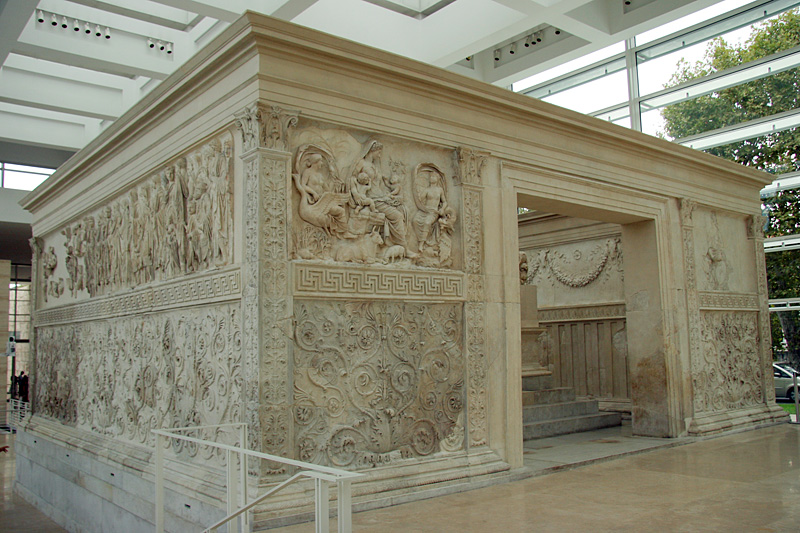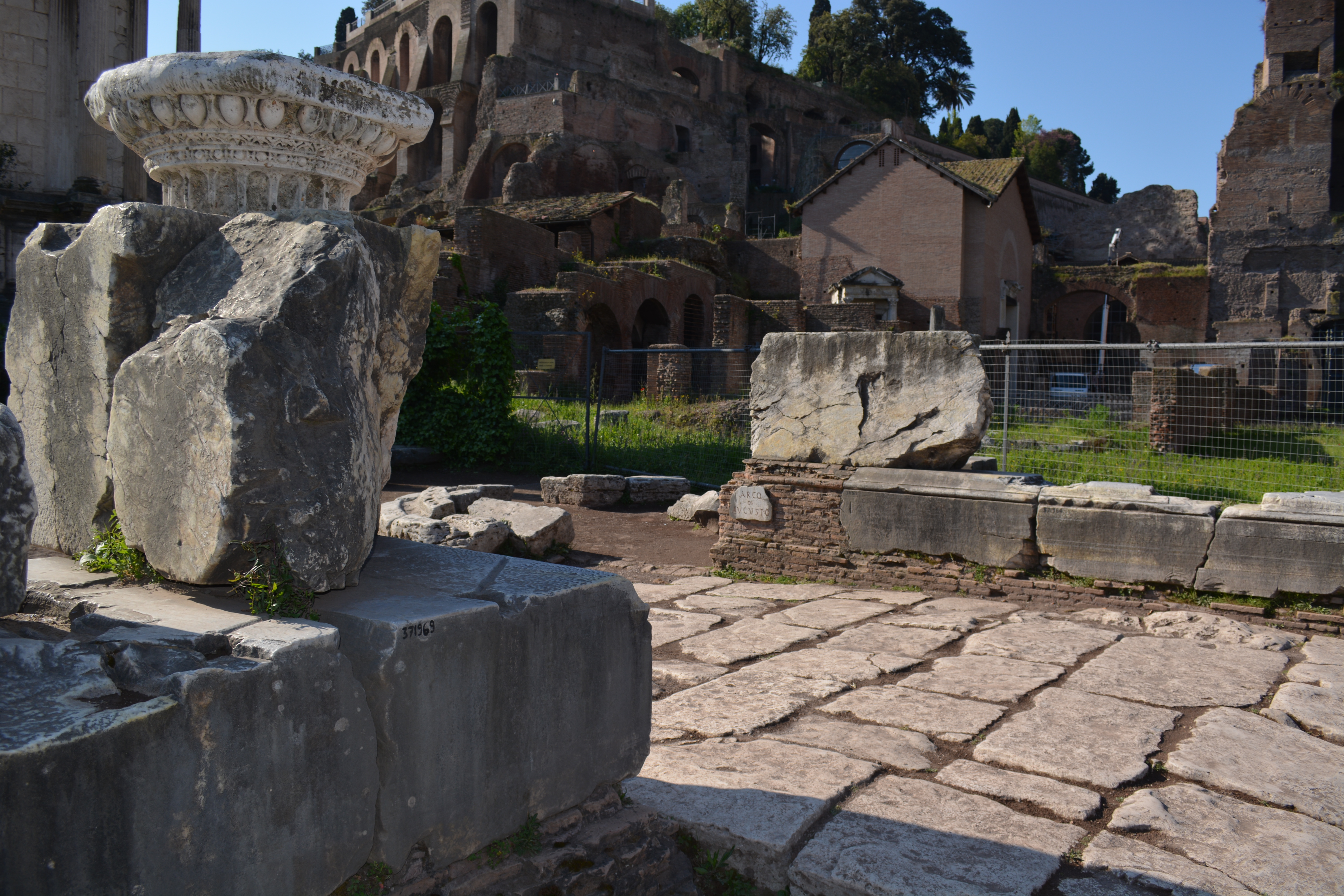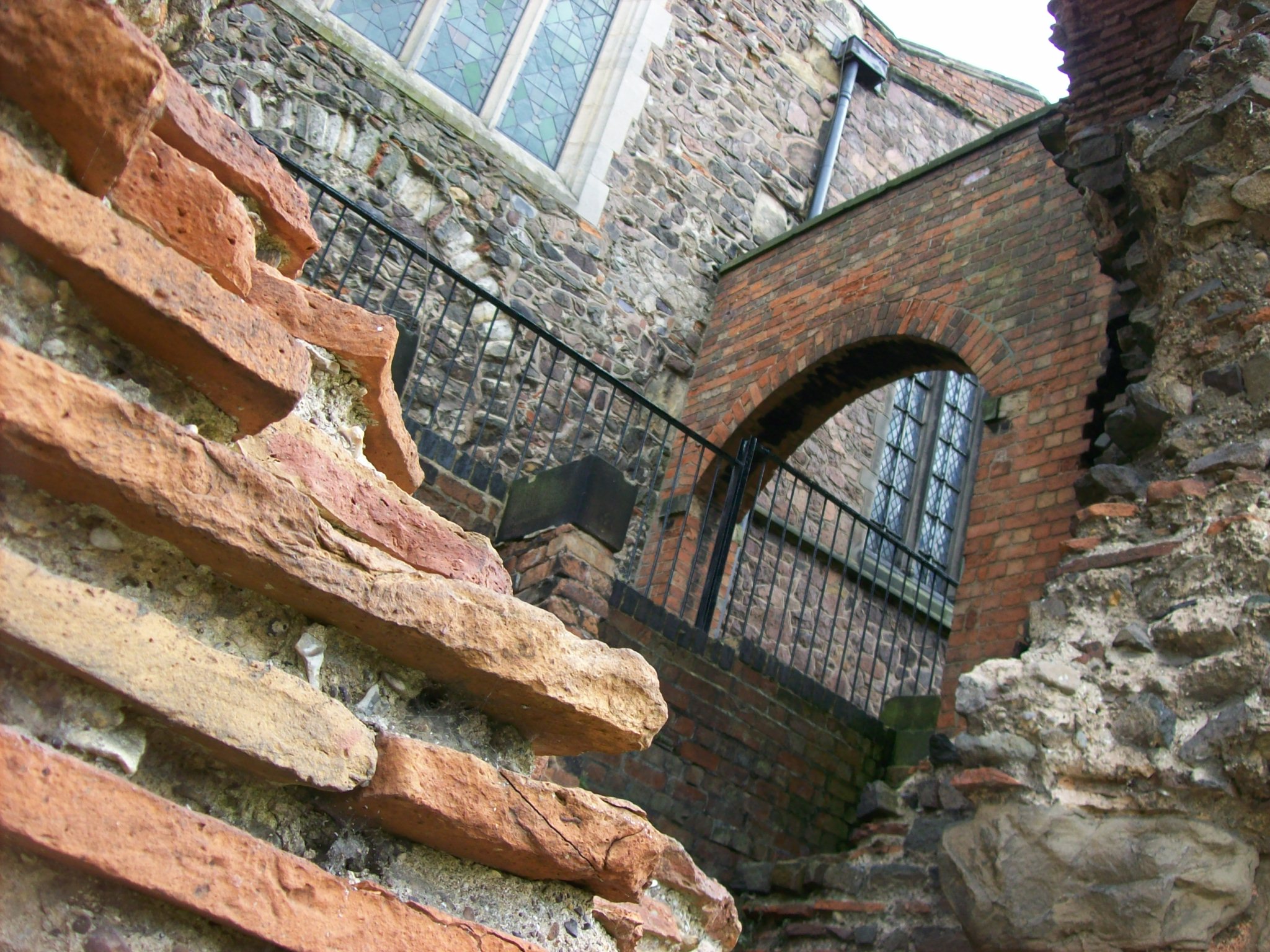|
Augustan And Julio-Claudian Art
Augustan and Julio-Claudian art is the artistic production that took place in the Roman Empire under the reign of Augustus and the Julio-Claudian dynasty, lasting from 44 BC to 69 AD. At that time Roman art developed towards a serene "neoclassicism", which reflected the political aims of Augustus and the Pax Romana, aimed at building a solid and idealized image of the empire. The art of the age of Augustus is characterized by refinement and elegance, adapted to the sobriety and measure that Augustus had imposed on himself and his court. During the principality of Augustus, a radical urban transformation of Rome began in a monumental sense. Suetonius recalls that: Still influential was the Greek sculpture from the 5th century BC, of which many works remained. This continuation of neo-Atticism influenced architecture, craftsmanship, and painting. Emblematic works of this era are the Ara Pacis, the Via Labicana Augustus, and the Augustus of Prima Porta. Evolution in the politics ... [...More Info...] [...Related Items...] OR: [Wikipedia] [Google] [Baidu] |
Ara Pacis (SW)
The (Latin, "Altar of Augustan Peace"; commonly shortened to ) is an altar in Rome dedicated to the Pax Romana. The monument was commissioned by the Roman Senate on July 4, 13 BC to honour the return of Augustus to Rome after three years in Hispania and Gaul and consecrated on January 30, 9 BC. Originally located on the northern outskirts of Rome, a Roman mile from the boundary of the ''pomerium'' on the west side of the Via Flaminia, the Ara Pacis stood in the northeastern corner of the Campus Martius, the former flood plain of the Tiber River and gradually became buried under of silt deposits. It was reassembled in its current location, now the Museum of the Ara Pacis, in 1938, turned 90° counterclockwise from its original orientation so that the original western side now faces south. Significance The altar reflects the Augustan vision of Religion in ancient Rome, Roman civil religion. The lower register of its frieze depicts agricultural work meant to communicate the abunda ... [...More Info...] [...Related Items...] OR: [Wikipedia] [Google] [Baidu] |
Pergamon
Pergamon or Pergamum ( or ; grc-gre, Πέργαμον), also referred to by its modern Greek form Pergamos (), was a rich and powerful ancient Greece, ancient Greek city in Mysia. It is located from the modern coastline of the Aegean Sea on a promontory on the north side of the river Caicus (modern-day Bakırçay) and northwest of the modern city of Bergama, Turkey. During the Hellenistic period, it became the capital of the Kingdom of Pergamon in 281–133 BC under the Attalid dynasty, who transformed it into one of the major cultural centres of the Greek world. Many remains of its monuments can still be seen and especially the masterpiece of the Pergamon Altar. Pergamon was the northernmost of the seven churches of Asia cited in the New Testament Book of Revelation. The city is centered on a mesa of andesite, which formed its acropolis. This mesa falls away sharply on the north, west, and east sides, but three natural terraces on the south side provide a route up to th ... [...More Info...] [...Related Items...] OR: [Wikipedia] [Google] [Baidu] |
Pompeian Style
The Pompeian Styles are four periods which are distinguished in ancient Roman mural painting. They were originally delineated and described by the German archaeologist August Mau (1840–1909) from the excavation of wall paintings at Pompeii, which is one of the largest group of surviving examples of Roman frescoes. The wall painting styles have allowed art historians to delineate the various phases of interior decoration in the centuries leading up to the eruption of Mount Vesuvius in 79 AD, which both destroyed the city and preserved the paintings, and between stylistic shifts in Roman art during late Republican and Augustan periods. In the succession of styles, there is a reiteration of stylistic themes. The paintings also tell a great deal about the prosperity of the area and specific tastes during the times. The main purpose of these frescoes was to reduce the claustrophobic interiors of Roman rooms, which were windowless and dark. The paintings, full of color and life, br ... [...More Info...] [...Related Items...] OR: [Wikipedia] [Google] [Baidu] |
Villa Di Livia, Affreschi Di Giardino, Parete Corta Meridionale 02
A villa is a type of house that was originally an ancient Roman upper class country house. Since its origins in the Roman villa, the idea and function of a villa have evolved considerably. After the fall of the Roman Republic, villas became small farming compounds, which were increasingly fortified in Late Antiquity, sometimes transferred to the Church for reuse as a monastery. Then they gradually re-evolved through the Middle Ages into elegant upper-class country homes. In the Early Modern period, any comfortable detached house with a garden near a city or town was likely to be described as a villa; most survivals have now been engulfed by suburbia. In modern parlance, "villa" can refer to various types and sizes of residences, ranging from the suburban semi-detached double villa to, in some countries, especially around the Mediterranean, residences of above average size in the countryside. Roman Roman villas included: * the ''villa urbana'', a suburban or country seat th ... [...More Info...] [...Related Items...] OR: [Wikipedia] [Google] [Baidu] |
Roman Agora
The Roman Agora ( el, Ρωμαϊκή Αγορά) at Athens is located to the north of the Acropolis and to the east of the Ancient Agora. History The Roman Agora was built around 100 metres east of the original agora by Eucles of Marathon between 27 BC and 17 BC (or possibly in 10 BC), using funds donated by Augustus, in fulfilment of a promise originally made by Julius Caesar in 51 BC. The Roman Agora has not today been fully excavated, but is known to have been a open space surrounded by a peristyle. To its south was a fountain. To its west, behind a marble colonnade, were shops and an Ionic propylaeum (entrance), the Gate of Athena Archegetis. To its east was a Doric gate, the East Propylon,Camp, 2001: 192 next to the Tower of the Winds and a set of " vespasianae" (public toilets). An inscription records the existence of an Agoranomion (an office for market officials). The Fethiye Mosque was built to the north during the Ottoman period. See also * Hadrian's Library H ... [...More Info...] [...Related Items...] OR: [Wikipedia] [Google] [Baidu] |
Titus
Titus Caesar Vespasianus ( ; 30 December 39 – 13 September 81 AD) was Roman emperor from 79 to 81. A member of the Flavian dynasty, Titus succeeded his father Vespasian upon his death. Before becoming emperor, Titus gained renown as a military commander, serving under his father in Judea during the First Jewish–Roman War. The campaign came to a brief halt with the death of emperor Nero in 68, launching Vespasian's bid for the imperial power during the Year of the Four Emperors. When Vespasian was declared Emperor on 1 July 69, Titus was left in charge of ending the Jewish rebellion. In 70, he besieged and captured Jerusalem, and destroyed the city and the Second Temple. For this achievement Titus was awarded a triumph; the Arch of Titus commemorates his victory to this day. During his father's rule, Titus gained notoriety in Rome serving as prefect of the Praetorian Guard, and for carrying on a controversial relationship with the Jewish queen Berenice. Despite concerns o ... [...More Info...] [...Related Items...] OR: [Wikipedia] [Google] [Baidu] |
Pula Arena
The Pula Arena ( hr, Pulska Arena; it, Arena di Pola) is a Roman amphitheatre located in Pula, Croatia. It is the only remaining Roman amphitheatre to have four side towers entirely preserved. It was constructed between 27 BC and AD 68, Kristina Džin: 2009, Page 7 and is among the world's six largest surviving Roman arenas. The arena is also the country's best-preserved ancient monument. The amphitheatre is depicted on the reverse of the Croatian 10 kuna banknote, issued in 1993, 1995, 2001 and 2004. History The Arena was built between 27 BC and 68 AD, as the city of Pula became a regional centre of Roman rule, called ''Pietas Julia''. The building is named after the sand (Latin ''harena'') that once covered the inner, performance area. It was built outside the town walls along the ''Via Flavia'', the road from Pula to Aquileia and Rome. The amphitheatre was first built in timber during the reign of Augustus (2–14 AD). It was replaced by a small stone amphitheatre during t ... [...More Info...] [...Related Items...] OR: [Wikipedia] [Google] [Baidu] |
Theatre Of Marcellus
The Theatre of Marcellus ( la, Theatrum Marcelli, it, Teatro di Marcello) is an ancient open-air theatre in Rome, Italy, built in the closing years of the Roman Republic. At the theatre, locals and visitors alike were able to watch performances of drama and song. Today its ancient edifice in the rione of Sant'Angelo, Rome, once again provides one of the city's many popular spectacles or tourist sites. Space for the theatre was cleared by Julius Caesar, who was murdered before its construction could begin; the theatre was advanced enough by 17 BC that part of the celebration of the ''ludi saeculares'' took place within the theatre; it was completed in 13 BC and formally inaugurated in 12 BC by Augustus,Leland M. Roth 1993 ''Understanding Architecture: Its Elements, History and Meaning'' (Westview Press: Boulder, CO and Cassius Dio 53.30.5., pp 230-31 named after his nephew Marcus Claudius Marcellus who had died in 23 BC. The theatre was 111 m in diameter and was the largest and ... [...More Info...] [...Related Items...] OR: [Wikipedia] [Google] [Baidu] |
Arch Of Augustus, Rome
The Arch of Augustus ( la, arcus Octaviani, it, Arco di Augusto) was the triumphal arch of Augustus, located in the Roman Forum. It spanned the Via Sacra, between the Temple of Castor and Pollux and the Temple of Caesar, near the Temple of Vesta, closing off the eastern end of the Forum. It can be regarded as the first permanent three-bayed arch ever built in Rome. The archaeological evidence shows the existence of a three-bayed arch measuring 17,75 x 5.25 meters between the Temple of Caesar and the Temple of Castor and Pollux, although only the travertine foundations of the structure remain. Ancient sources mention arches erected in honor of Augustus in the Forum on two occasions: the victory over Antony and Cleopatra in 31 BC, and the recovery of the standards lost to the Parthians in 20 BC. Actian Arch Cassius Dio reports that after the Battle of Actium the Senate granted Augustus a triumph and an arch in an unspecified spot in the Forum. No contemporary descriptio ... [...More Info...] [...Related Items...] OR: [Wikipedia] [Google] [Baidu] |
Roman Brick
Roman brick can refer either to a type of brick used in Ancient Roman architecture and spread by the Romans to the lands they conquered; or to a modern type inspired by the ancient prototypes. In both cases, it characteristically has longer and flatter dimensions than those of standard modern bricks. Ancient The Romans only developed fired clay bricks under the Empire, but had previously used mudbrick, dried only by the sun and therefore much weaker and only suitable for smaller buildings. Development began under Augustus, using techniques developed by the Greeks, who had been using fired bricks much longer, and the earliest dated building in Rome to make use of fired brick is the Theatre of Marcellus, completed in 13 BC. Subsequent uses of fired brick included the Scrongulus Amphitheatre, completed shortly after. Though its use of brick was innovative at the time, the theatre collapsed in a conflict soon thereafter. The process of drying bricks in a kiln made it so these bricks ... [...More Info...] [...Related Items...] OR: [Wikipedia] [Google] [Baidu] |
Tower Of The Winds - Panoramio - Robert Freeman (1)
A tower is a tall structure, taller than it is wide, often by a significant factor. Towers are distinguished from masts by their lack of guy-wires and are therefore, along with tall buildings, self-supporting structures. Towers are specifically distinguished from buildings in that they are built not to be habitable but to serve other functions using the height of the tower. For example, the height of a clock tower improves the visibility of the clock, and the height of a tower in a fortified building such as a castle increases the visibility of the surroundings for defensive purposes. Towers may also be built for observation, leisure, or telecommunication purposes. A tower can stand alone or be supported by adjacent buildings, or it may be a feature on top of a larger structure or building. Etymology Old English ''torr'' is from Latin ''turris'' via Old French ''tor''. The Latin term together with Greek τύρσις was loaned from a pre-Indo-European Mediterranean language, ... [...More Info...] [...Related Items...] OR: [Wikipedia] [Google] [Baidu] |
.jpg)

_-_Turkey_-_10_(5747249729).jpg)

.jpg)

